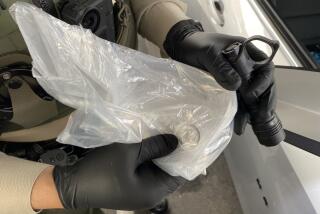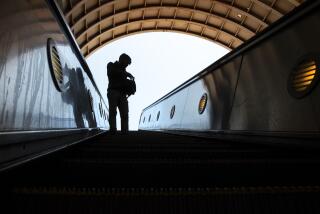Securing the Future
From his office window in Jersey City, Joseph Atick stared across the Hudson River to lower Manhattan last week and was jolted by the sight of twin skyscrapers set aflame by hijacked passenger jets.
“It was just unbelievable,” said Atick, who lost a friend in the attack. “To see the skyline altered once and for all without the World Trade Center is a major shock.”
It took several hours for the reality to set in. But once it did, Atick and his colleagues at Visionics Corp. redoubled their efforts to create a security system that can identify terrorists and other criminals by studying their faces.
“We feel we’re doing something to help this country defend itself,” said Atick, chief executive and co-founder of the 7-year-old company.
Across the country and around the world, companies like Visionics are developing technologies designed to make airports and air travel safer. In the wake of last week’s terrorist attacks against the United States, government officials and security experts are looking for ways to speed these technologies’ transition from research laboratories to airport ticket counters and boarding gates.
Officials from the Federal Bureau of Investigation and the Federal Aviation Administration won’t publicly discuss their plans for enhancing security at the nation’s airports. But companies at the cutting edge of technology say they began receiving calls from government agencies soon after last week’s attacks in New York and at the Pentagon.
Syagen Technology Inc., a 5-year-old start-up in Tustin, has a $1-million grant from the FAA to develop a machine with Sandia National Laboratories that can detect trace amounts of explosives. Though it resembles an oversized metal detector, the so-called aviation security portal is designed to sniff out bombs.
The machine starts by collecting a sample of particles from each airline passenger. One by one, they stand in an opening about the size of a small shower stall while fans blow air into a filter for about five seconds. The sample is then sifted so that captured particles, residues and vapors are concentrated for testing. The amount of residue on a single fingertip is 1,000 times greater than what is needed to conduct the test.
Once collected, the molecules are excited to a specific energy level. Then they are fed into a specialized mass spectrometer, which measures how long it takes for each one to hit a detector.
When the “time of flight” is known, the machine uses a simple physics equation to calculate the molecule’s mass. That, in turn, allows the machine to identify the particle, said Jack Syage, the company’s founder and chief executive.
Syagen and Sandia are preparing to deploy the aviation security portal for testing at an airport, where it could screen five passengers a minute. The machine is designed to look for traces of TNT and about 10 kinds of plastic explosives, but it could be modified to test for toxic chemicals such as nerve agent sarin and mustard gas. Other Syagen products already test for compounds used to make chemical weapons.
Syagen expects to sell its first detectors directly to the FAA, which would deploy them in airports. Though interest in the device has been heightened in light of recent events, the timetable for deployment is still uncertain, said Brent Evans, the company’s chief operating officer.
InVision Technologies Inc. of Newark, Calif., already has some of its million-dollar explosive-detection machines deployed in airports. They are based on adaptations of the computed tomography technology used in hospital CT scanners.
InVision’s X-ray mechanism rotates around a piece of luggage and produces images that reveal the mass and density of the objects inside. A computer compares the images with the properties of known explosives, and the system sounds an alarm if a possible match is found. Its CTX 9000 DSi system can scan as many as 542 pieces of luggage an hour, according to the company.
Though such systems could thwart future attacks, neither would have been likely to prevent last week’s coordinated hijackings because the attackers apparently used simple weapons such as knives and box cutters.
So other companies are specializing in biometric technology that identifies people based on physical characteristics such as fingerprints and facial structure.
“It’s not necessarily what they’ve got in their pockets or their bags but who they are,” said Clinton Morrison, director of equity research for Miller Johnson Steichen Kinnard in Minneapolis.
Visionics is one of the most promising companies in the burgeoning field of biometrics. Its facial recognition system has been deployed at Keflavik International Airport in Reykjavik, Iceland, and in a few cities. After the company set up 300 cameras in the Newham section of London to find violent criminals, drug dealers and members of organized crime rings, the crime rate dropped 40% in one year, Atick said.
Visionics’ software can analyze faces captured on security cameras that are already installed in U.S. airports. After extracting an individual face from a crowd, it can create a unique mathematical identifier called a “faceprint.”
Each faceprint is based on measurements of about 20 of the 80 landmarks on a human face, such as the bridge of the nose, the protrusion of a cheekbone, the arch of an eyebrow and the precise location of the corner of the mouth. A person’s faceprint is set by the time he or she is 2 years old, and it can’t be altered by changing one’s hairstyle or shaving a beard, Atick said.
Once a faceprint is calculated, it can be compared with faceprints of known terrorists and other criminals already on file in a database. The Visionics system can check 1 million records a second.
Although faces lifted from security cameras can be used to create faceprints, Atick advocates changing the entire airline boarding process so that passengers are required to look directly into a camera and provide their faceprint when they hand over a boarding pass. Such a system would cost a few hundred thousand dollars for most airports and probably wouldn’t top $750,000 for a large facility such as Los Angeles International Airport.
“Just like a Visa or American Express transaction doesn’t go through until you get authorization approval, a person will only be authorized to board a plane if their face doesn’t match a terrorist,” he said. “Terrorism is not faceless. We had pictures of two of the terrorists from the attacks.”
Fingerprint identification technology also could help spot terrorists before they board airplanes. Such systems are already in place at U.S. borders to flag suspected illegal immigrants, and they could be installed at airports in less than a month, said Wally Briefs, a senior vice president at Cogent Systems Inc.
Briefs’ South Pasadena firm makes the software for the federal Immigration and Naturalization Service’s fingerprint identification system, known by the acronym IDENT. That system compares a person’s prints and photograph against a “lookout” list of wanted criminals in less than two minutes--about the time it takes to check a bag and obtain a boarding pass.
In an airport, a security system could reduce a person’s fingerprint to a bar code and print it on a boarding pass. Then a fingerprint reader at the gate could ensure that the passenger who went through the security check is the same person who boards the plane, Briefs said.
Of course, biometric identification systems can work only if airlines are able to tap into a centralized database of fingerprints or faceprints of criminal suspects. Though the FBI, the Central Intelligence Agency and various state agencies maintain their own records, no common database exists.
“We need a counter-terrorism initiative with a database,” Atick said. “If agencies step up to the plate today and said, ‘We will provide the database,’ we could give you a system tomorrow.”
Even with a database, such systems will aid in capturing only people who have already been identified--using traditional intelligence techniques--as possible terrorists. A terrorist who’s legally in the United States and not wanted by any law enforcement agency would sail right through.
One possible solution is to expand the lookout list to include all the prints on file with federal and state law enforcement agencies. But some observers doubt it would result in more useful matches, and it would surely draw howls from civil libertarians because of its potential to increase the number of people falsely identified as suspects.
“In the 1990s, biometrics over-promised and under-delivered,” said Dick Ryan, vice president for research at Dougherty & Co., an investment firm in Minneapolis that tracks security technologies. “Now you’re getting the technology at price points where it’s hard to say, ‘This doesn’t make sense.’ ”
*
Times staff writer Karen Kaplan covers the Internet. Times staff writer Jon Healey contributed to this report.
More to Read
Sign up for Essential California
The most important California stories and recommendations in your inbox every morning.
You may occasionally receive promotional content from the Los Angeles Times.











